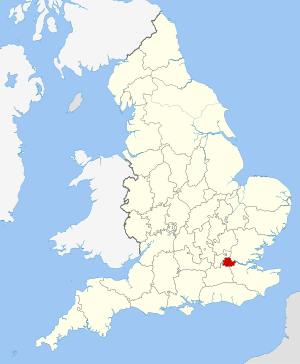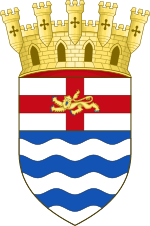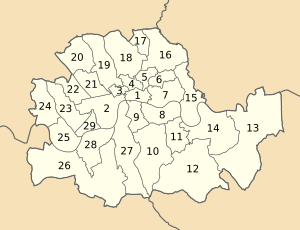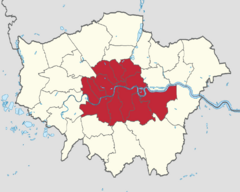County of London facts for kids
| London County of London |
|
 |
|
| Geography | |
| Status | Administrative and (smaller) ceremonial county |
| 1911 area | 74,816 acres (302.77 km2) |
| 1961 area | 74,903 acres (303.12 km2) |
| HQ | County Hall, Lambeth |
| History | |
| Origin | District of the Metropolitan Board of Works |
| Created | 1889 |
| Abolished | 1965 |
| Succeeded by | Greater London |
Quick facts for kids Demography |
|
|---|---|
| 1911 population - 1911 density |
4,521,685 60/acre |
| 1961 population - 1961 density |
3,200,484 42/acre |
| Politics | |
| Governance | London County Council |
 |
|
| Subdivisions | |
| Type | Parishes and districts (1889–1900) Metropolitan boroughs (1900–1965) |
 |
|
The County of London was a special area in England that existed from 1889 to 1965. It covered the part of London we now call Inner London. This county was created when England decided to have elected local governments across the country.
The main group in charge of the County of London was the London County Council (LCC). They started with a few jobs but took on more and more over 76 years. The county was about 74,903 acres (303.12 km2) in size by 1961. Over time, fewer people lived in the county as many moved to areas outside it. In 1965, the County of London was replaced by a much larger area called Greater London.
Contents
Exploring London's Geography
The County of London was a bit smaller than 75,000 acres (30,351 ha). It was located in a natural dip in the land called the London Basin. The most important natural feature was the River Thames, which split the county into two parts: north and south.
The county shared borders with other areas. To the north-east, it met the River Lea and Essex. To the south-east, it bordered Kent. Surrey was to the south-west, and Middlesex was to the north. The highest point in the county was Hampstead Heath, which is about 440 feet (134 m) high.
A Brief History of the County
The County of London was created to help manage the growing city better. Before it, a group called the Metropolitan Board of Works looked after things like roads and sanitation. This board managed parts of Middlesex, Surrey, and Kent that were considered "the Metropolis." The old City of London had its own separate government.
How the County Was Formed
For many years, people tried to improve how London was governed. They wanted to either make the City of London bigger or create a new county just for London. These ideas often failed because the City of London Corporation had a lot of power.
Finally, the Local Government Act 1888 helped create county councils across England. This law made it possible to create the County of London. The new county covered the same area that the Metropolitan Board of Works had managed. This area didn't perfectly match where London had grown, but it was chosen for simplicity.
The City of London and the County of London were separate for special "non-administrative" reasons, like having their own Lord Lieutenant. However, the County Council's power also included the City of London, though they had very little control over the ancient City's daily affairs.
The London County Council
The main local government for the county was the London County Council (LCC). The LCC took over the jobs from the Metropolitan Board of Works. Over time, it also took on responsibilities from other groups, like the London School Board, which managed schools.
The council first worked from Spring Gardens. Later, in the 1930s, they moved to a special building called County Hall. The LCC also built many large housing areas, even some outside the county's borders, like the one at Becontree.
Population Changes Over Time
After World War I, the number of people living in the County of London started to drop. This trend continued until the county ended in 1965. In 1901, about 4.5 million people lived there. By 1961, this number had fallen to 3.2 million. More and more people were choosing to live in the areas just outside the county.
The End of the County
The County of London officially ended in 1965. It was replaced by a much larger area called Greater London. This new area included almost all of Middlesex, plus parts of Surrey, Kent, Essex, and Hertfordshire.
The area that used to be the County of London is now known as Inner London. The 28 smaller areas within the old county, called metropolitan boroughs, were combined to form 12 new London boroughs.


